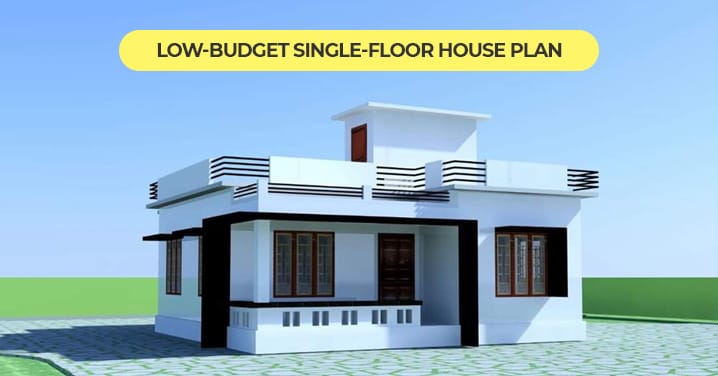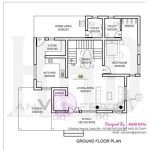Simple Kerala House Plans With Photos: A Guide to Traditional and Modern Designs
Kerala, a state known for its lush greenery and serene backwaters, also boasts a distinct architectural style in its residential designs. Simple Kerala house plans are characterized by their functionality, connection to nature, and utilization of locally available materials. These plans often incorporate traditional elements while adapting to contemporary needs and preferences. This article explores various aspects of simple Kerala house plans, highlighting their key features and showcasing examples through photographs.
When considering a house plan in Kerala, several factors come into play. The climate, with its heavy monsoon rains and warm temperatures, necessitates designs that promote ventilation and protect against the elements. Cultural preferences, which emphasize family living and communal spaces, also influence the layout. Furthermore, the availability and cost of building materials, such as laterite stone, wood, and tiles, directly impact the construction process.
Modern interpretations of simple Kerala house plans retain the essence of traditional architecture while incorporating contemporary amenities and technologies. These designs often feature open floor plans, energy-efficient features, and modern finishes. The goal is to create homes that are both aesthetically pleasing and functional for modern living.
Key Features of Traditional Kerala House Plans
Traditional Kerala house plans are deeply rooted in architectural principles derived from "Vastu Shastra," an ancient Indian system of architecture. This system emphasizes the harmonious integration of the building with its environment, taking into account factors such as cardinal directions, sunlight, and wind flow. The use of "Thachu Shastra," a traditional carpentry system, ensures structural stability and aesthetic appeal.
One of the most distinctive features of traditional Kerala houses is the sloping roof, designed to effectively drain rainwater. These roofs are typically constructed using clay tiles, which provide excellent insulation and contribute to the overall cooling of the house. The overhangs of the roof also provide shade, protecting the walls from direct sunlight and reducing heat gain.
Another defining characteristic is the "padippura," or gatehouse, which serves as the main entrance to the property. The padippura is often intricately designed and adorned with carvings, signifying the importance of hospitality and welcoming guests. The courtyard, or "nadumuttam," is a central open space that provides ventilation and natural light to the surrounding rooms. It also serves as a gathering place for family activities and cultural events. The nadumuttam often features a "thulasi thara," a raised platform for the holy basil plant, which is considered sacred in Hindu tradition.
The use of wood is prevalent in traditional Kerala houses, especially for doors, windows, and structural elements. Teak wood is highly prized for its durability and resistance to pests. Intricate carvings and detailing are often incorporated into the wooden elements, adding to the aesthetic appeal of the house. Laterite stone, a readily available local material, is commonly used for the foundation and walls. This stone is porous, allowing for good ventilation and contributing to the cool interior environment.
The traditional Kerala house plan typically includes a "pooja room," a dedicated space for prayer and meditation. This room is often located in the northeast corner of the house, considered the most auspicious direction according to Vastu Shastra. The kitchen is traditionally located in the southeast corner, and the bedrooms are situated away from the main entrance to ensure privacy.
Here are some examples of traditional Kerala house plans with characteristic features:

This image showcases a traditional Kerala house with a sloping tiled roof, a prominent veranda, and wooden pillars. Note the use of natural materials and the open layout.

This image highlights the central courtyard (nadumuttam) a key feature of traditional Kerala homes, providing light and ventilation.
Modern Adaptations of Kerala House Plans
Modern Kerala house plans often incorporate contemporary design elements while retaining the core principles of traditional architecture. These adaptations aim to create homes that are both aesthetically pleasing and functional for modern living. Open floor plans, energy-efficient features, and modern finishes are common characteristics of these designs.
One of the key changes in modern Kerala house plans is the incorporation of larger windows and glass panels to maximize natural light. This is often done in conjunction with the traditional sloping roof and overhangs to control the amount of sunlight entering the house and prevent overheating. Modern materials, such as concrete and steel, are also used in conjunction with traditional materials like laterite stone and wood, providing structural strength and durability.
The use of energy-efficient technologies is another important aspect of modern Kerala house plans. Solar panels, rainwater harvesting systems, and energy-efficient lighting are increasingly being incorporated to reduce the environmental impact and lower energy costs. Green building practices, such as using sustainable materials and minimizing waste during construction, are also gaining popularity.
Modern Kerala house plans often feature open kitchens and living areas, creating a more spacious and interactive living environment. The bedrooms are typically designed with attached bathrooms and walk-in closets, providing added convenience and privacy. The landscaping around the house is also carefully planned to create a seamless connection between the indoor and outdoor spaces.
Here are some examples of modern Kerala house plans that blend traditional and contemporary elements:

This image showcases a modern Kerala house with a contemporary design while still incorporating the traditional sloping roof for effective rainwater drainage.

This image exemplifies a modern Kerala house with large windows and an open floor plan, promoting natural light and ventilation.
Considerations for Choosing a Simple Kerala House Plan
When selecting a simple Kerala house plan, several factors should be taken into consideration. The size of the plot, the budget, the family's needs and preferences, and the local climate are all important considerations. It is also essential to consult with an architect or designer who is familiar with Kerala's architectural traditions and building regulations.
The size of the plot will determine the maximum size of the house and the layout of the rooms. A smaller plot will require a more compact design, while a larger plot will allow for a more spacious and elaborate layout. The budget will influence the choice of materials, finishes, and amenities. It is important to set a realistic budget and prioritize the essential features of the house.
The family's needs and preferences should also be considered when selecting a house plan. A family with young children may require a different layout than a family with older children or elderly parents. The number of bedrooms, bathrooms, and living areas should be tailored to the family's specific requirements. The lifestyle of the family should also be taken into account. A family that enjoys entertaining guests may require a larger living area and a well-equipped kitchen.
The local climate should also be considered when selecting a house plan. In Kerala's humid climate, it is important to choose a design that promotes ventilation and natural light. The orientation of the house should also be considered to maximize sunlight and minimize heat gain. The use of appropriate materials, such as clay tiles and laterite stone, can also help to keep the house cool and comfortable.
Finally, it is essential to obtain all necessary permits and approvals before starting construction. Building regulations vary from one municipality to another, and it is important to comply with all applicable rules and regulations. Consulting with a qualified architect or engineer can help to ensure that the house is built safely and according to code.
Ultimately, the ideal simple Kerala house plan is one that combines functionality, aesthetics, and sustainability. By carefully considering the various factors outlined above, it is possible to create a home that is both comfortable and aesthetically pleasing, while also respecting Kerala's rich architectural heritage.

Small Kerala House Plans At 1000 Square Feet Everyone Will Like Acha Homes Page

Best Kerala House Designs Floor Design Plans And Ideas

Kerala Simple House Design

Simple And Beautiful Kerala Style 3 Bedroom House In 1153 Square Feet With Plan

Small Single Floor House

60 Kerala House Designs Trending In 2024 Traditional And Modern Look

Kerala House Plans Designs Floor And Elevation

Kerala Style Single Floor House Plan 1155 Sq Ft Home Design And Plans 10k Dream Houses

60 Kerala House Designs Trending In 2024 Traditional And Modern Look

How To Plan A Low Budget Single Floor House In Kerala








